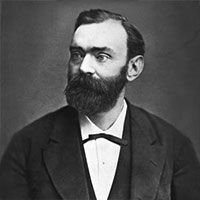Alfred Nobel
Alfred Bernhard Nobel was a Swedish chemist, engineer, inventor, businessman, and philanthropist. He is best known for having bequeathed his fortune to establish the Nobel Prize, though he also made several important contributions to science, holding 355 patents in his lifetime.
Alfred Nobel, in full Alfred Bernhard Nobel,a Swedish chemist, engineer, and industrialist who invented dynamite and other more powerful explosives and who also founded the Nobel Prizes.
Alfred Nobel was the fourth son of Immanuel and Caroline Nobel. Immanuel was an inventor and engineer. Alfred was prone to illness as a child, but he enjoyed a close relationship with his mother and displayed a lively intellectual curiosity from an early age. He was interested in explosives, and he learned the fundamentals of engineering from his father. The Nobel family left Stockholm in 1842 to join the father in St. Petersburg where they established a successful business. Alfred’s prosperous parents were now able to send him to private tutors, and he proved to be an eager pupil. He was a competent chemist by age 16 and was fluent in English, French, German, and Russian as well as Swedish.
Alfred Nobel left Russia in 1850 to spend a year in Paris studying chemistry and then spent time in the United States working under the direction of John Ericsson, the builder of the ironclad warship Monitor. Upon his return to St. Petersburg, in 1852, Nobel worked in his father’s factory, which made military equipment during the Crimean War. After the war their company went bankrupt. Alfred and his parents returned to Sweden. Alfred soon began experimenting with explosives in a small laboratory on his father’s estate. At the time, the only dependable explosive for use in mines was black powder, a form of gunpowder. A recently discovered liquid compound, nitroglycerin, was a much more powerful explosive, but it was so unstable that it could not be handled with any degree of safety. Nevertheless, Nobel in 1862 built a small factory to manufacture nitroglycerin, and at the same time he undertook research in the hope of finding a safe way to control the explosive’s detonation. In 1863 he invented a practical detonator consisting of a wooden plug inserted into a larger charge of nitroglycerin held in a metal container; the explosion of the plug’s small charge of black powder serves to detonate the much more powerful charge of liquid nitroglycerin. This detonator marked the beginning of Nobel’s reputation as an inventor as well as the fortune he was to acquire as a maker of explosives. In 1865 Nobel invented an improved detonator called a blasting cap; it consisted of a small metal cap containing a charge of mercury fulminate that can be exploded by either shock or moderate heat. The invention of the blasting cap inaugurated the modern use of high explosives.
Nitroglycerin itself, however, remained difficult to transport and extremely dangerous to handle. Nevertheless, Nobel built several factories to manufacture nitroglycerin for use in concert with his blasting caps.
Nobel’s second important invention was that of dynamite in 1867. By chance, he discovered that nitroglycerin was absorbed to dryness by kieselguhr, a porous siliceous earth, and the resulting mixture was much safer to use and easier to handle than nitroglycerin alone. Nobel named the new product dynamite and was granted patents for it in Great Britain (1867) and the United States (1868). Dynamite established Nobel’s fame worldwide and was soon put to use in blasting tunnels, cutting canals, and building railways and roads.
In the 1870s and ’80s Nobel built a network of factories throughout Europe to manufacture dynamite, and he formed a web of corporations to produce and market his explosives. He also continued to experiment in search of better ones, and in 1875 he invented a more powerful form of dynamite, blasting gelatin, which he patented the following year. Again by chance, he had discovered that mixing a solution of nitroglycerin with a fluffy substance known as nitrocellulose results in a tough, plastic material that has a high water resistance and greater blasting power than ordinary dynamites. In 1887 Nobel introduced ballistite, one of the first nitroglycerin smokeless powders and a precursor of cordite.
Alfred’s worldwide interests in explosives, along with his own holdings in his brothers’ companies in Russia, brought him a large fortune. In 1893 he became interested in Sweden’s arms industry, and the following year he bought an ironworks at Bofors, near Varmland, that became the nucleus of the well-known Bofors arms factory. Besides explosives, Nobel made many other inventions, such as artificial silk and leather, and altogether he registered more than 350 patents in various countries.
Nobel’s complex personality puzzled his contemporaries. He never married, and apparently preferred the joys of inventing to those of romantic attachment. He had amazing energy and found it difficult to relax after intense bouts of work.
At his death his worldwide business empire consisted of more than 90 factories manufacturing explosives and ammunition. The opening of his will, which he had drawn up in Paris on November 27, 1895, and had deposited in a bank in Stockholm, contained a great surprise for his family, friends, and the general public. He had always been generous in humanitarian and scientific philanthropies, and he left the bulk of his fortune in trust to establish what came to be the most highly regarded of international awards, the Nobel Prizes.

Alfred Nobel
Date of Birth: 21 Oct 1833
Birth Place: Stockholm, Sweden
Proffession: Swedish chemist
Nationality: Swedish
Death: 10 December 1896, Sanremo, Italy


